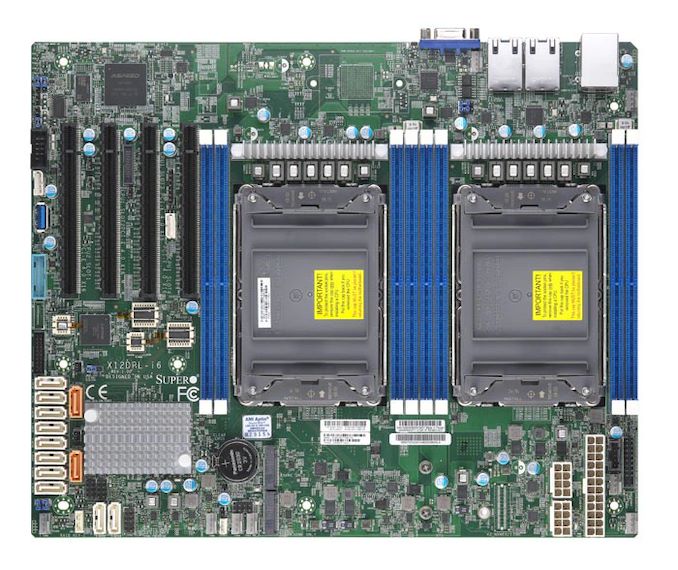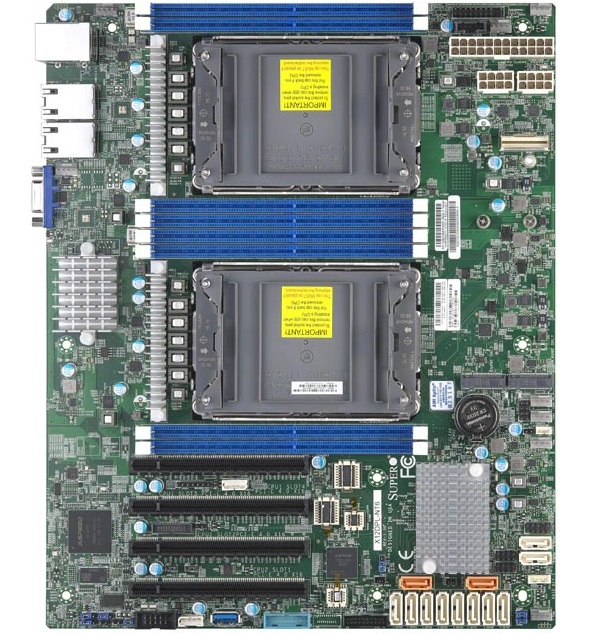Supermicro: We Put Two 10nm Ice Lake Xeon LGA4189 Sockets on an ATX Motherboard
by Gavin Bonshor on May 10, 2021 10:00 AM EST
Usually, when vendors release dual-socket motherboards, this is typically done on larger form factors such as extended ATX (E-ATX) and even larger ones such as SSB-EEB for server form factors. Supermicro looks to buck the trend and has recently listed a pair of Intel motherboards with dual LGA4189 sockets, designed for Intel's latest Ice Lake 3rd Gen Xeon Scalable processors.
Both the Supermicro X12DPL-NT6 and X12DPL-i6 conform to the ATX form factor and have a very similar design. The key metrics include support for two Intel 3rd generation Ice Lake Xeon processors but also eight memory slots between the two, indicating that each processor runs in only quad-channel mode. This is important as some enterprise situations do not require the full memory bandwidth of eight memory channels, and thus having fewer physical channels on board helps with form factor as well as cost. That being said, this motherboard can support up to 2TB of DDR4-3200 ECC memory (1 TB per socket). Also, due to the size of the board, Supermicro recommends that only 185 W TDP processors maximum are used.

The Supermicro X12DPL-NT6 ATX motherboard
Towards the bottom of the board is four full-length PCIe 4.0 x16 slots, each with single slot spacing. Providing both physical and remote access to the system is ASPEEDs latest AST2600 BMC controller. For storage, the chipset is powering twelve SATA ports with support for RAID 0, 1, 5, and 10 arrays. Both models also include two PCIe 4.0 x4 M.2 slots, supporting both 22110/2280 M.2 form factors, while the second port is limited to 2280 M.2.
Focusing on the differences between the two boards, the X12DPL-NT6 is the higher-end variant. It includes a dual 10 G-Base T Ethernet powered by an Intel X550 controller, which is cooled by a heatsink, and it also includes an additional PCIe 4.0 x8 port for NVMe drives. The Supermicro X12DPL-i6 instead dual Intel i210 Gigabit controllers and does not have the additional PCIe 4.0 x8.
On the rear panels, both models include two USB 3.2 G1 Type-A ports, with an additional port on the motherboard directly at the bottom. There is also a USB 3.2 G1 front panel header that offers an additional two Type-A ports.
At the time of writing, we don't know when the Supermicro X12DPL-NT6 or the X12DPL-i6 will be available to purchase, nor do we have any pricing information at this time. But fitting a dual-socket design on a simple ATX is rather fun.
Related Reading
- Intel 3rd Gen Xeon Scalable (Ice Lake SP) Review: Generationally Big, Competitively Small
- Intel's Full Enterprise Portfolio: An Interview with VP of Xeon, Lisa Spelman
- GIGABYTE Server: Three New E-ATX Motherboards For Intel Ice Lake-SP Xeons
- Axiomtek Unveils IMB700 Motherboard, LGA4189 For Intel Ice Lake-SP










22 Comments
View All Comments
alfalfacat - Monday, May 10, 2021 - link
While impressive, you are throwing away most of the platform - half your memory channels, most of your PCIe, half the TDP headroom (this is is the real shocker), etc. - to fit in the size and layout constraints. ATX is just the wrong form-factor, and if you have to I feel like going single-socket is much more practical.AdrianBc - Monday, May 10, 2021 - link
Going single-socket is of course much more practical ... if you are using an Epyc.This motherboard is the only way to have an ATX MB with Intel CPUs having a higher performance than an ATX MB with AMD CPUs.
The memory is the same as for a single-socket MB, so you lose only 3 PCIe slots, while doubling the number of CPU cores.
If you are happy with that, there may be some cases when this MB is an acceptable choice.
AdrianBc - Monday, May 10, 2021 - link
Actually, after looking at the Intel Ice Lake Xeon price list, where, for example, 2 dual-socket 16-core CPUs have the same price as 1 single-socket 32-core CPU, the main advantage of this MB is the better cooling of the cores (370 W TDP vs. 205 W TDP), which allows a much higher all-core clock frequency, e.g. 3.3 GHz vs. 2.9 GHz.Because the Epyc Milan CPUs have a much higher clock frequency at the same number of active cores and the same power consumption, the only way to exceed their performance with Ice Lake Xeon is to allow a more generous TDP, like with this motherboard.
Because the Ice Lake Xeons with few cores, i.e. in the 16 ... 32 cores range, have now a more decent price, not much different from AMD, with a MB like this you might be able to match or exceed the Epyc price/performance, but with the price of a much higher power consumption.
Kevin G - Monday, May 10, 2021 - link
One thing being thrown away is memory bandwidth. This board only has 8 of the 16 memory channels present which can be an issue for some select workloads. A solution to this that might still work is to leverage SO-DIMM slots. Put two slots end to end where you have a single full sized slot on this board. The chip package looks like this might be feasible from a trace layout stand point too. You won't get as much capacity per DIMM but the bandwidth side would be boosted by the channel increase.I suspect that SuperMicro could support higher TDP chips on a board this physical size but they'd have to add more CPU power headers and a more robust VRM. Those take up board space but perhaps it is time to split the VRM on both sides of a socket for Ice Lake-SP. In terms of CPU cooling, liquid would be the only way to go outside of super high air flow server chassis. Being a standard ATX board does imply some usage outside of a typical rackmount server.
The one "nice" thing that has happened is that as software licensing has shifted from a per socket model to a per core model. The quotations are there as overall prices have generally increased moving to the per core model, these licensing models have not penalizing multisocket systems as much. Thus the the theory adding a second socket vs. a single larger socket system for greater performance could also lead to a better performance per dollar scenario. Have to really read the fine print and do the math as this is far from universal.
Regardless, this board is relatively dense and has its niche that'll pay for it. I wonder how many PCB layers it has.
antonkochubey - Monday, May 10, 2021 - link
>A solution to this that might still work is to leverage SO-DIMM slots.RDIMM memory modules don't exist in SO-DIMM form-factor, and I'm not sure those CPUs even support UDIMM's.
bhtooefr - Thursday, May 13, 2021 - link
SORDIMMs do exist: https://industrial.apacer.com/en-ww/DRAM/DDR4-SORD...Ian Cutress - Monday, May 10, 2021 - link
You'd be surprised at the wide variety of requirements in enterprise. Those that don't need memory capacity/bandwidth or PCIe and just focused on raw compute will pay for a customized system. AMD announced on Milan that they included 4-channel and 6-channel memory interleaving for customers that need only 4-channel or 6-channel memory, saving those customers money in design and server density.Zizy - Monday, May 10, 2021 - link
The general point is true, but AMD had 4 channel support before Milan (*you* wrote about that! https://www.anandtech.com/show/16529/amd-epyc-mila... Milan added 6 channel, I guess for folks migrating from Intel and keeping their memory.mode_13h - Tuesday, May 11, 2021 - link
> You'd be surprised at the wide variety of requirements in enterprise.This could be aimed more at embedded or appliance applications.
MenhirMike - Monday, May 10, 2021 - link
I can see some use if you need AVX-512, but the lack of TDP Headroom seems like an issue then. Even for a workstation, a SSI-EEB Board wouldn't make the tower case THAT much bigger. Dual Socket ATX seems like a weird compromise, even more so than HEDT ITX.